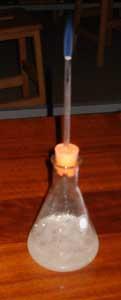Demonstrations designed to capture the student's imagination
Carbon monoxide (CO) is a highly toxic, colourless, odourless and flammable gas. It is toxic at levels of only 0.1 per cent (1000 ppm). Carbon monoxide's toxicity arises from its ability to bind to transition metals such as iron in haemoglobin, the oxygen-carrier protein in blood. By binding strongly to the Fe-centre of haemoglobin, CO blocks the uptake of oxygen and thereby its transport around the body.
A product of volcanic activity, CO is present in the atmosphere at ca 0.1 ppm. But today CO is recognised as a polluting gas produced by the incomplete combustion of carbon-based fuels, eg in the internal combustion engine with CO present in car exhaust fumes. In urban areas such as Mexico City CO levels can rise to 100-200 ppm.
Carbon monoxide has, however, many important industrial uses. For example, the gas is used extensively for the extraction of nickel in the Mond process, and in the reduction of iron oxide in the blast furnace, where the CO is produced in situ from the reaction between carbon dioxide and red-hot coke.
Find out more
Carbon monoxide - the silent killer explains all about this deadly gas and how scientists are tackling the dangers. With practice questions for learners to apply their understanding of bonding, redox and equilibrium in transition metal chemistry to less familiar contexts.
Making carbon monoxide
Carbon monoxide is made industrially in the manufacture of synthesis gas from the reaction of alkanes with steam. In the laboratory an easy way to prepare CO is by the dehydration of concentrated methanoic acid using concentrated sulfuric acid1
HCOOH(l) → CO(g) + H2 O(l)
The CO evolved can then be ignited to show that the gas burns with a pale blue flame.

Kit
- 250 ml conical flask with a bung attached to a delivery tube for collecting over water;
- trough filled with water, beehive shelf, gas jars and cover slips;
- 50 ml concentrated sulfuric acid;
- 50 ml concentrated methanoic acid;
- a splint attached to a metre rule to be used as a taper;
- nitrile gloves, goggles and a ducted (not filter or recirculatory) fume cupboard.
Safety
Perform both the preparation and demonstration in a ducted fume cupboard. Filter (re-circulatory) fume cupboards must not be used because carbon monoxide is not absorbed by the filters. Concentrated sulfuric and methanoic acids are corrosive and can cause severe burns to the skin and eyes. Wear goggles (or face shield) and nitrile gloves throughout, and take great care igniting the CO gas in case of an explosion. The amount of methanoic acid suggested could produce up to 30 litres of CO gas. Carbon monoxide's toxicity requires that the apparatus must remain in a fume cupboard and that the products are carefully poured into a large volume of water (or, better, a mixture of ice and water) and then disposed of down the fume cupboard sink and washed away with plenty of cold water.
Procedure
In a ducted fume cupboard pour 50 ml of concentrated methanoic acid into a 250 ml conical flask and then carefully add 50 ml of concentrated sulfuric acid. Stopper the flask with the rubber bung containing the delivery tube and gently swirl the mixture. You should see a reaction start, producing bubbles of carbon monoxide. Leave the apparatus to stand for ca 30 seconds, to ensure the air is flushed from the conical flask, before collecting the gas over water. Carefully ignite the gas collected in the gas jar. Once you have proved that the carbon monoxide is not mixed with air (ie it burns quietly, with no explosion), you could quickly replace the delivery tube with a jet (vertical glass delivery tube) and ignite the gas at the jet. (Note: this will be tricky because CO will be being given off.)
Special tips
The blue colour of the burning carbon monoxide is best viewed in a darkened room. Don't panic if a bit of CO escapes into the classroom; anything less than about 20 litres will not raise the concentration to toxic levels.
Teaching goals
The incomplete combustion of fuels features at GCSE and is discussed at KS3, so I find it helpful to demonstrate the properties of CO, and to show that it burns with a beautiful blue flame. The following simple equations, which use methane as an example fuel, illustrate the formation of CO and soot - C(s) - from the incomplete combustion of fuels:
complete combustion:
CH4 (g) + 2O2 (g) → CO2 (g) + 2H2 O(g)
inadequate oxygen supply:
CH4 (g) + 1.5O2 (g) → CO(g) + 2H2 O(g)
inadequate oxygen supply:
CH4 (g) + O2 (g) → C(s) + 2H2 O(g)
With sixthform groups the structure of CO can be discussed, starting with a proposed Lewis dot-and-cross diagram followed by a discussion of the proposed resonance structure of CO.









No comments yet